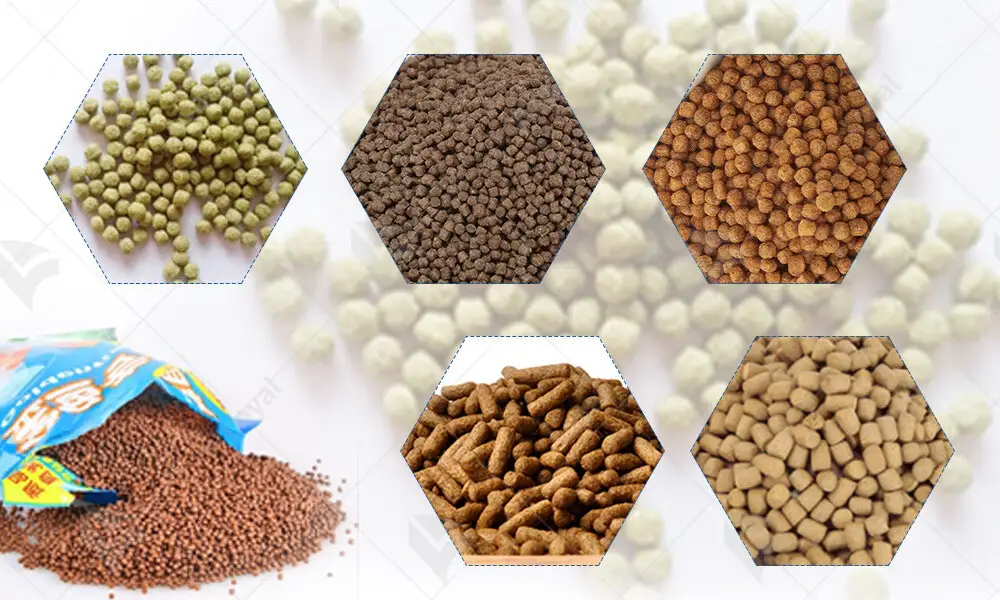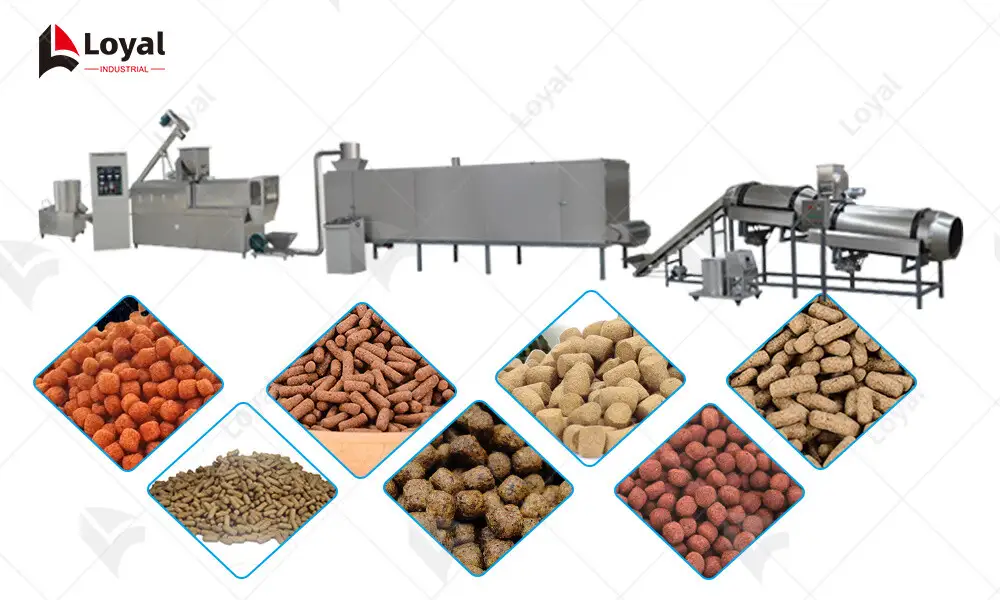How To Choose The Bestfish food extruder machine: 2024 Buyer’s Guide
Introduction to Fish Food Extruder Machines
In the realm of aquaculture, the quality of nutrition provided to fish is paramount. It directly influences their growth, health, and ultimately, the profitability of fish farming operations. This is where fish food extruder machines have revolutionized the industry, playing a crucial role in the production of high-quality, nutrient-dense fish feed.
Fish food extruder machines are industrial food processing equipment specifically designed to formulate and extrude fish feed. These machines have been in use for decades, evolving from rudimentary designs to highly sophisticated pieces of technology. The basic principle behind their operation involves mixing various raw ingredients, such as proteins, fats, carbohydrates, vitamins, and minerals, under controlled conditions of temperature, pressure, and moisture. The mixture is then forced through a die, shaping it into the desired form, such as pellets or strips, which are easy for fish to consume.
The importance of fish nutrition cannot be overstated. Fish, being cold-blooded animals, have a higher metabolic rate than warm-blooded animals, making them more reliant on a steady supply of nutrients to sustain their growth and energy levels. In the wild, fish obtain these nutrients from a diverse range of sources, including algae, insects, other fish, and plant matter. However, in aquaculture settings, where fish are often reared in high densities, providing them with a balanced and nutritious diet becomes a challenge. This is where fish food extruder machines come into play.
Early fish food extruder machines were relatively simple, relying on manual operation and basic machinery. However, as the aquaculture industry grew, so did the demand for more efficient and effective fish feed production methods. This led to the development of more advanced fish food extruder machines, incorporating automation, precision control, and advanced formulation techniques. Today, these machines are capable of producing a wide range of fish feeds, tailored to the specific needs of different fish species and stages of growth.
In conclusion, fish food extruder machines are essential pieces of equipment in the aquaculture industry. They play a vital role in ensuring that fish receive the high-quality nutrition they need to thrive. As the industry continues to evolve, so too will the technology behind fish food extruder machines, driving further improvements in fish nutrition and aquaculture productivity.

The Benefits of Adopting Fish Food Extruder Machines
The adoption of fish food extruder machines in aquaculture brings numerous benefits that address the challenges faced by traditional fish food production methods. These advanced machines are revolutionizing feed manufacturing, leading to improved efficiency, sustainability, and product quality.
1.One of the primary advantages of using a fish food extruder machine is the enhancement of feed quality. The extrusion process applies heat and pressure to raw materials, which not only sterilizes the feed but also improves its digestibility. This results in feed that is more palatable and nutritionally balanced, ensuring optimal growth and health for fish. By providing high-quality feed, aquaculture producers can significantly reduce feed waste and improve overall productivity.
2.Another critical benefit is the operational efficiency gained from using fish food extruder machines. These machines are designed for high throughput, allowing for the rapid production of large quantities of feed. This capability is particularly important in an industry where demand can fluctuate dramatically. With the ability to produce consistent, high-quality feed quickly, aquaculture businesses can respond more effectively to market needs.
3.Additionally, fish food extruder machines offer a high level of customization. Producers can adjust the formulation and processing parameters to create specific feed types tailored to the unique dietary needs of different fish species. This flexibility is essential in modern aquaculture, where diverse species are often raised in the same environment. By meeting the specific nutritional requirements of each species, producers can enhance growth rates and overall fish health.
4.Furthermore, the sustainability of aquaculture practices is greatly improved through the use of fish food extruder machines. These machines help minimize waste by optimizing ingredient utilization and allowing for the incorporation of alternative protein sources, such as by-products from other industries. This not only reduces reliance on traditional fishmeal but also supports a more circular economy within the aquaculture sector.

Challenges Faced by Traditional Fish Food Production Methods
In the realm of aquaculture, the efficiency and quality of fish feed are paramount to the health and growth of aquatic species. However, traditional fish food production methods have faced numerous challenges that have hindered the optimal development of this crucial industry.
One of the most significant challenges faced by traditional fish food production is the inconsistency in feed quality. Traditional methods often rely on manual mixing and formulation, which can lead to variations in ingredient proportions and nutrient content. This inconsistency can adversely affect the growth rates, health, and overall performance of aquatic animals. Moreover, the lack of precision in feed formulation can result in waste and increased production costs.
Furthermore, traditional fish food production methods often struggle with scalability. As aquaculture operations expand, the demand for fish feed increases exponentially. Traditional methods, which are largely labor-intensive and time-consuming, fail to meet this growing demand efficiently. This limitation can lead to bottlenecks in production and hinder the expansion of aquaculture businesses.
Another challenge is the difficulty in achieving the desired texture and shape of fish feed. Traditional methods may not provide the necessary precision in forming and extruding feed, resulting in pellets that are either too hard or too soft, or have irregular shapes. These inconsistencies can affect the palatability and digestibility of the feed, ultimately impacting the performance of aquatic animals.
Moreover, traditional fish food production methods often lack the ability to customize feed formulations based on the specific needs of different aquatic species. Different fish have varying nutritional requirements, and a one-size-fits-all approach to feed production can lead to suboptimal growth and health outcomes. The inability to tailor feed formulations to meet these species-specific needs further undermines the efficiency of traditional production methods.
To address these challenges, the aquaculture industry has increasingly turned to advanced fish food extruder machine technologies. These machines offer a level of precision, scalability, and customization that traditional methods cannot match. By utilizing extruder machines, producers can achieve consistent feed quality, scalability in production, and the ability to tailor feed formulations to meet the specific needs of different aquatic species.

Key Benefits of Using Advanced Fish Food Extruder Machine Technologies
In the ever-evolving landscape of aquaculture, the adoption of advanced technologies has become a necessity to enhance production efficiency and sustainability. Among these technologies, the fish food extruder machine stands out as a game-changer.Below, I outline the key benefits of using advanced fish food extruder machine technologies.
Consistency in Feed Quality | One of the most compelling benefits of advanced fish food extruder machines is their ability to ensure consistency in feed quality. These machines utilize precision engineering and automated processes to mix, formulate, and extrude fish feed with remarkable accuracy. This consistency in feed quality translates to more predictable growth rates, improved health outcomes, and reduced waste for aquatic animals. By eliminating the variability associated with traditional production methods, extruder machines help aquaculture producers achieve optimal feed efficiency and cost savings. |
Scalability and Efficiency | Another significant advantage of advanced fish food extruder machines is their scalability and efficiency. As aquaculture operations expand, the demand for fish feed grows accordingly. Extruder machines are designed to handle increased production volumes seamlessly, allowing producers to scale up their operations without compromising feed quality or production speed. This scalability is crucial for maintaining competitiveness in the rapidly growing aquaculture market. Moreover, extruder machines optimize the use of raw materials and reduce energy consumption, further enhancing production efficiency. By minimizing waste and maximizing output, these machines contribute to a more sustainable aquaculture industry. |
Customization of Feed Formulations | Advanced fish food extruder machines also offer the capability to customize feed formulations based on the specific needs of different aquatic species. This customization is achieved through precise control over ingredient proportions, extrusion temperatures, and other critical parameters. By tailoring feed formulations to meet the nutritional requirements of specific fish species, extruder machines help producers achieve optimal growth and health outcomes. This level of customization is particularly important in the context of evolving consumer preferences and regulatory requirements. As consumers become more aware of the nutritional benefits of different aquatic species, the demand for tailored feed formulations is likely to increase. Advanced extruder machines are well-equipped to meet this demand, ensuring that aquaculture producers can stay ahead of the curve. |
Improved Feed Texture and Digestibility | Finally, advanced fish food extruder machines enhance the texture and digestibility of fish feed. By carefully controlling the extrusion process, these machines produce pellets that are uniform in size, shape, and hardness. This consistency in pellet quality improves the palatability and digestibility of the feed, leading to better growth performance and health outcomes for aquatic animals. Moreover, extruder machines can incorporate various ingredients and additives to improve the nutritional profile and functional properties of fish feed. For example, the inclusion of probiotics, enzymes, and other bioactives can enhance the immune response and overall health of aquatic animals. By leveraging the capabilities of advanced extruder machines, aquaculture producers can develop innovative feed formulations that meet the evolving needs of their operations. |
In conclusion, the adoption of advanced fish food extruder machine technologies offers numerous benefits to the aquaculture industry. From consistency in feed quality to scalability and efficiency, customization of feed formulations, and improved feed texture and digestibility, these machines are transforming the way fish feed is produced and utilized. As the aquaculture industry continues to grow and evolve, the role of advanced extruder machines in enhancing production efficiency and sustainability will become even more critical.

Advanced Fish Food Extruder Machine Technologies
In the realm of industrial food machinery, advanced fish food extruder machine technologies are revolutionizing the aquaculture industry. In this article, I will delve into the intricacies of advanced fish food extruder machine technologies, highlighting their innovative features and the benefits they bring to aquaculture operations.
Innovative Design and Engineering | Advanced fish food extruder machines are designed with cutting-edge technology and precision engineering. These machines incorporate state-of-the-art components such as high-torque motors, precision gearboxes, and advanced control systems to ensure optimal performance and reliability. The extruder screws, which are the heart of the machine, are crafted from durable materials and precision-ground to exact specifications, ensuring consistent feed output and minimal wear and tear. Moreover, these machines feature modular designs that allow for easy maintenance and upgrades. This adaptability is crucial in the fast-paced world of aquaculture, where technological advancements are constantly being made. With advanced fish food extruder machines, producers can stay ahead of the curve, incorporating the latest innovations to enhance their operations. |
Precision Formulation and Mixing | One of the most significant advancements in fish food extruder machine technologies is the precision formulation and mixing capabilities. These machines utilize automated systems to accurately measure and blend raw materials, ensuring consistent feed formulations that meet the nutritional requirements of different aquatic species. The mixing chambers are designed to provide thorough and uniform blending, eliminating the risk of ingredient segregation and ensuring a homogeneous feed mix. Furthermore, advanced extruder machines incorporate precise temperature control systems to maintain optimal processing temperatures throughout the extrusion process. This ensures that the feed is cooked to the correct degree, enhancing its digestibility and palatability for aquatic animals. By achieving precise formulation and mixing, these machines contribute to the overall quality and effectiveness of fish feed. |
Customizable Extrusion Processes | Another key feature of advanced fish food extruder machines is their customizable extrusion processes. These machines allow producers to adjust various parameters such as screw speed, temperature, and pressure to tailor the extrusion process to their specific needs. This level of customization enables producers to create a wide range of feed textures, shapes, and sizes, catering to the preferences of different aquatic species. Moreover, customizable extrusion processes allow producers to optimize feed production for different stages of aquatic animal growth. For example, early-life stages may require smaller, more easily digestible pellets, while mature fish may benefit from larger, more nutrient-dense feed particles. By leveraging the customizable features of advanced extruder machines, producers can ensure that their fish receive the optimal feed formulations throughout their life cycles. |

Reference
The following are five authoritative foreign literature websites in the field of Industrial food machinery:
1. Food Engineering Magazine
Website: https://www.foodengineeringmag.com/
2.Food Processing Magazine
Website: https://www.foodprocessing.com/
3.Journal of Food Engineering
Website:https://www.journals.elsevier.com/journal-of-food-engineering
4. Food Manufacturing Magazine
Website:https://www.foodmanufacturing.com/
5. International Journal of Food Science & Technology
Website:https://onlinelibrary.wiley.com/












